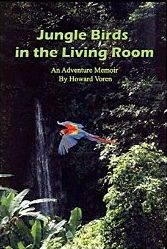The Yellow-Shouldered Amazon
© Howard Voren. Click here to use this content.The yellow-shouldered Amazon is a very special bird. Its scientific name is Amazona barbadensis and those who work with them affectionately call them Barbies. They are in fact the Barbie Dolls of the Amazon world. They are best described as being a perfectly proportioned and beautifully colored blue-fronted Amazon in miniature. The major difference being that the barbie has a white forehead and a horn colored beak. There is another pretty color variation that is only seen in barbies. There are somtimes a few scattered feathers with red on them; where the white of its forehead meets the yellow on the top of its’ head. This gives some of the yellow feathers an orange appearance while some of the white feathers will appear to have a pinkish coloration. The green body feathers of the subspecies that is most often seen in the U.S. have a moderate to heavy blue wash to them.
There are two types (subspecies) of yellow-shouldereds. One exists in two localities along the coast of Venezuela. The other is found off the Venezuelan coast on a few islands that are part of a chain called the Lesser Antilles. One of them is as described above. The other is larger and has the yellow on its’ head covering a much greater area. This subspecies looks more like a super small yellow-headed Amazon.
There is some confusion as to which bird comes from the mainland and which is from the Islands. The island bird is the rothschildi subspecies. In some older texts it is referred to as Rothschild’s Amazon. In PARROTS OF THE WORLDS by J. Forshaw, the smaller one with less extensive yellow on the head is listed as the rarer island variety. Due to Forshaw’s masterwork this is also what most aviculturists in the U.S. believe. I however have good reason to believe the opposite. I know of at least eight birds that were brought into the U.S. by Venezuelan immigrants as part of their household possessions. All of them were purchased on the mainland from local trappers that have no means or reason to smuggle the island variety into Venezuela. Secondly the vast majority of all the birds I have seen in the U.S. are as well; the smaller, and in my opinion, prettier variety. It is agreed to that the island form, which ever it may be, is much rarer than the mainland form. I find it difficult to believe that the rarer form would exist here in greater numbers than the one from the mainland. Last but not least, personal communication with an aviculturists who traveled to the region has also solidified my feelings. He claimed that his travels proved to him that somehow the descriptions got reversed.
Although both types of yellow-shouldereds are listed as endangered species, they are still a very popular pet bird in Venezuela. In fact they are the pet bird of choice among cosmopolitan Venezuelans. Here in the U.S. they are breeding reliably and very steadily. The pairs that we have at the institute never disappoint us. Although they are on the international endangered list they are not on our federal list. This means they can be freely traded within the U.S. without permits. They are a bird that is very popular with aviculturists who make the decision to invest in some of the rarer Amazons. Aviaries are now producing enough of them to allow many to go into the pet trade. The pet potential of Barbies’ is extraordinary. Most that we have known remain sweet and gentile into adulthood. They also have the advantage of being very quiet, for an Amazon. These attributes endear them to all that have ever had them as a companion.


